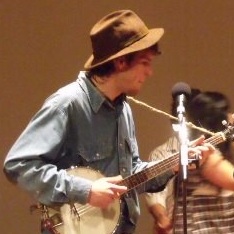
Noah Turner Myers: First of all, I think readers will notice a great variety of literary themes in these three stories: the mundane, the ironic, the supernatural, humor, etc. How do you explain such variety? Do the themes depend on your mood, or do you go through different phases?
KA: Honestly, I can’t imagine myself within monotony. I’m terrified of overly alike spaces, a woman that’s always beautiful, a tree that’s always green —or always dry, the same. So I think the variety in my writing occurs naturally. I jump from one theme or locale to another because that’s how it comes out of me, but also because as a short story reader, that’s what I look for in a good collection. I find it boring to read a story that sounds just like the previous one (if that were the case, I would rather read a novel in which all or almost all chapters are connected) and that’s why I like to read anthologies where not only the themes and styles vary, but also the voices.
NTM: Literary critics are always debating whether we’re still in the period of post-modernism or post-post-modernism. Is there an -ism you would apply to your work or do you prefer to avoid labels?
KA: It’s not that I avoid or invite them, I’m just faithful to the text. I have been «labeled» in the genre of Dirty Realism (or hyper-realism), and I do see a lot of that in my texts, but I don’t think that single term defines all of my work. A story comes to me and it comes with a narrator, a style, a time period, etc. I write totally without regard to literary criticism, readers, narration, outside world. In that moment, the story is the world. I don’t even take those outside factors into account during the editing process, since I understand that there are all different kinds of tastes, and endless colors. As I once heard Junot Díaz say, «on the shelves of a library, there is more than one book,» which is why I believe that you shouldn’t write with the intention of pleasing others. At the same time, if my work were to transcend, someday, some being of the future will come up with a definition for this period.
NTM: The majority of the stories in your collection El tragaluz del sótano are genuine micro-literature, just a few pages. What do you like about this genre and have you tried other genres?
KA: The short story has always been my greatest passion. So much so that when I write a text of more than seven pages I congratulate myself. Nevertheless, I have ventured with other genres. In 2013, I published a poetry collection called CUANDO EL RESTO SE APAGA (Proyecto Zompopos), and this year my first children’s book, MÍA, ESTEBAN Y LAS NUEVAS PALABRAS / MÍA, ESTEBAN AND THE NEW WORDS (Alfaguara) came out. I’ve also written a couple of short novels, of which one was published in 9 IRIS Y OTROS MALDITOS CUENTOS (Ed. Nacional, 2010) and some juvenile fiction. At this time I am experimenting with minucuentos or híperbreves, as they are often called. Here we no longer speak of pages but of words. It is a challenge to fit a story within such limitations; there’s no room to spare, no room for tails, as Borges used to call them. I am intrigued by the challenge, for sure.
NTM: One of the stereotypes surrounding Latino writers in the US is the focus on the tribulations of the immigrant experience or longing for one’s homeland. This is not at all the case with these stories, and while some clearly occur in a US or Dominican context, others seem to transcend place. Is this on purpose?
KA: This question can be answered the same way I answered the second question: I’m faithful to the text. I write about what comes to me, based on what I see, what I dream, what I hear, what I desire, what I am and hate being, what I seek to be. Since I’m a Dominican woman living in the US, you can find some hints of a «here» and an «over there» but they aren’t universal immigrant characteristics. They’re the traces I leave behind from my unique experience. There may be stories, as you mention, with plots that occur in the Dominican Republic, just as there are ones that occur in Russia, Vienna, Germany, etc. Others simply exist in a nowhere place, in a place where many times we come to find ourselves.
NTM: Some see writing as catharsis, some as social critique and others just as a way to make a living. What role does your writing play in your life and what impact do you hope to have on readers?
KA: Catharsis, yes. Social critique, perhaps; a way to make a living, no. As a human being, I try to be just, even good. I detest hypocrisy and lack of consciousness. I live trying to grow and not do harm. But not as an author. As an author, I write; what comes out of those lines, out of those stories underneath is a matter reserved for the story and the reader. Make a living writing? Ja. I’m not that delusional. I acknowledge that if I did not write, I would drown «in my throat the seeds would die.» I write and that allows me to breathe; I benefit from the writing in order to be a little happier, everything that comes after is a bonus, a gift. I want to reach the reader, in whichever way. I think that what is important is that people read us even if it is to identify him/herself with the piece, to criticize the text, to hate us, or simply «to talk about [our work] even in a good way,» as our great José Kozer often says.
NTM: Primero que nada, creo que los lectores verán en estos tres cuentos una gran variedad de temas: lo cotidiano, lo irónico, lo sobrenatural, el humor, etc. ¿Cómo explicas tanta variedad? ¿Los temas varían según tu humor o pasas por épocas diferentes?
KA: La verdad es que no me concibo en lo monótono. Me aterra un espacio demasiado parecido a otro, una mujer siempre bella, un árbol siempre verde —o siempre seco—, lo mismo. Por eso creo que la variedad en mi literatura se da natural. Salto de un tema, de una localidad a otra porque así me sale pero también porque cuando leo un libro de cuentos, en particular, eso es lo que busco. Me aburre mucho leer cuentos similares a los anteriores (pues para eso leo una novela donde todos o casi todos los capítulos nos conectan a un tema matriz) y por eso me gusta leer antologías donde no solo los temas y los estilos difieren uno del otro, sino incluso las voces.
NTM: Los críticos debaten si estamos en la época posmodernista o pos-posmodernista o algo distinto. ¿Hay algún -ismo que te gusta aplicar a tus cuentos o prefieres evitar etiquetas?
KA: No es que evite ni que invite, yo soy fiel al texto. Se me ha «etiquetado» bajo el género Realismo Sucio (o híper-realismo), y sí veo mucho de eso en algunos de mis textos pero no creo que el rótulo defina todo el trabajo. El cuento me llega y me llega con narrador, con estilo, con tiempo, etc. Yo escribo absolutamente ajena a crítica, a lector, a narratorio, a mundo. En ese momento el cuento es el mundo. Ni siquiera en el momento de editar tomo en cuenta estos factores pues entiendo que hay muchos gustos y un sinfín de colores. Como una vez le escuché decir a Junot Díaz, «en los estantes de una biblioteca no hay un solo libro», por eso creo que no se debería escribir pensando en complacer. Asimismo, si mi trabajo llegara a trascender, la época ya la definirá algún ser del futuro.
NTM: La mayoría de la colección de El tragaluz del sótano son verdaderos micro-cuentos, unas pocas páginas. ¿Qué te atrae de este género y has explorado otros géneros?
KA: El cuento corto siempre ha sido mi pasión mayor. Tanto así que cuando escribo un texto de más de siete páginas me felicito a mí misma. Aun así, sí, he incursionado en otros géneros. En 2013 publiqué un poemario titulado CUANDO EL RESTO SE APAGA (Proyecto Zompopos), y este año salió mi primer libro de literatura infantil MÍA, ESTEBAN Y LAS NUEVAS PALABRAS / MÍA, ESTEBAN AND THE NEW WORDS (Alfaguara). He escrito un par de novelas cortas, de las cuales una salió publicada en 9 IRIS Y OTROS MALDITOS CUENTOS (Ed. Nacional, 2010) y algunos cuentos juveniles. En estos momentos estoy explorando los caminos de los minicuentos o híperbreves, como también se le suele llamar. Aquí ya no hablamos de páginas sino de palabras. Es un reto el poder meter una historia en tan poco espacio, no hay cabida para la sobra, para los rabos, como los llamaba Borges; estoy cautivada, no hay duda.
NTM: Un estereotipo de los autores «latinos» en Estados Unidos es que casi siempre se enfocan en las tribulaciones del inmigrante o la añoranza de la patria. Eso no se ve para nada en estos cuentos y aunque hay ciertos cuentos que claramente ocurren en la R.D. y otros en EE.UU., muchos trascienden un lugar específico. ¿Esto es a propósito?
KA: Esta pregunta te la puedo contestar con las mismas palabras que respondí la pregunta dos: Soy fiel al texto. Escribo de lo que me llega, de lo que veo, de lo que sueño, de lo escucho, de lo que deseo, de lo que soy y odio ser, de lo que pretendo. Debido a que soy una mujer dominicana que vive en los Estados Unidos, encontraremos rasgos de un allá y de un aquí pero no son los rasgos de todos los inmigrantes; son mis huellas, mi muy particular experiencia. Habrá cuentos, como indicas, cuya trama transcurre en República Dominicana, como hay otros que toman lugar en Rusia, Viena, Alemania, etc. Otros que simplemente existen, en ningún lado, donde tantas veces llegamos a encontrarnos.
NTM: Algunos ven la escritura como catarsis, otros como compromiso social y otros como una mera manera de ganarse el pan. ¿Qué papel juega la escritura en tu vida y qué impacto deseas tener sobre el lector?
KA: Catarsis, sí; compromiso social, talvez; una manera de ganarme el pan, no. Como ser humano trato de ser justa, incluso buena. Detesto la hipocresía y la falta de consciencia. Vivo tratando de crecer y de no dañar. Como escritora no. Como escritora escribo, lo que surja de entre esas líneas, de entre esos cuentos de más abajo, es cosa exclusiva del cuento y del lector.
¿Ganarme la vida escribiendo? Ja. No soy tan ilusa. Reconozco que si no escribiera, me ahogaría «en mi garganta morirían las semillas». Escribo y eso me permite respirar; me beneficio de la escritura para ser un poco más feliz, todo lo que venga después es añadidura, regalo. Al lector quiero llegarle, de la manera que sea. Creo que lo importante es que se nos lea así sea para que quien lo haga se identifique con el texto, para que se nos critique, para que se nos odie, o simplemente «para que hablen de [nuestro trabajo] aunque sea en bien», como suele decir nuestro gran José Kozer.

Noah Myers fell in love with the Spanish language and culture of Latin America growing up, of all places, in rural Missouri. During his BA, he studied in Mendoza, Argentina, and later taught English in Tunja, Colombia, before going on to complete his MA in Hispanic Literature from the University of North Carolina. He has published reviews and presented scholarly works about a variety of subjects, with particular interest in contemporary afro-descendent and indigenous writers of Colombia and the Caribbean. This is his first, and he hopes the first of many, literary translations.







